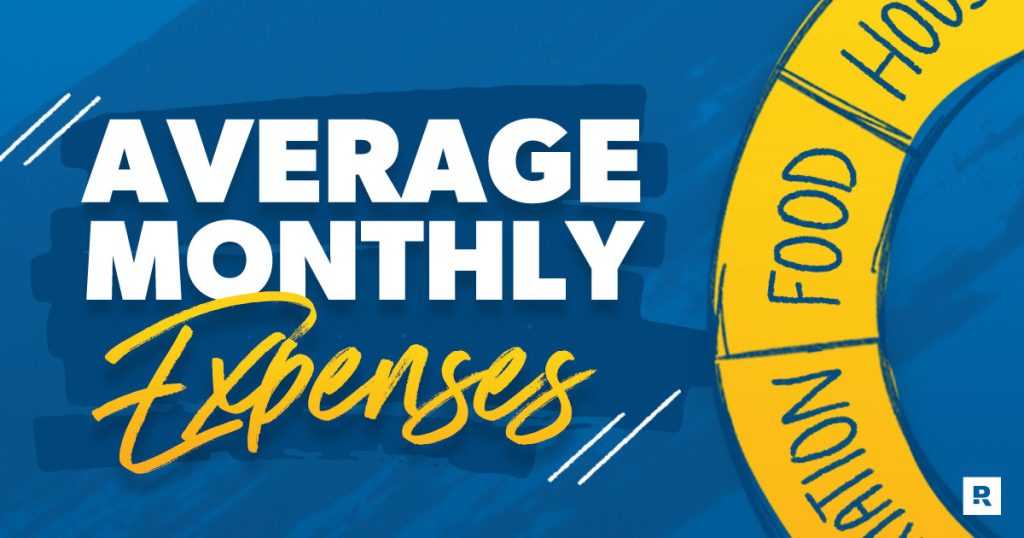Money’s tight for just about everybody right now (thanks, inflation). As you look for ways to cut costs, you’re probably wondering, Is everyone spending this much on food? What are the average monthly expenses?
Well, here’s what we do know: The average monthly expenses for an American household are about $6,440.1 That adds up to $77,280 per year. And these numbers come straight from the folks at the Bureau of Labor Statistics (BLS) who keep track of what Americans spend on everything from cereal to toilet paper to housing.
But everyone’s situation is different. So, let’s dig in to each monthly expense category a little more.
Average Monthly Expenses by Household Size
How much you spend on monthly expenses depends on several factors, including how many people you have living in your home. That said, here are the average monthly expense costs by household size:
- A single person household spends an average of $4,641 on monthly expenses.
- Married couples without kids spend an average of $7,390 on monthly expenses.
- A family of four spends an average of $8,450–9,817 on monthly expenses (depending on kids’ ages).2
Remember, these are averages, so they could vary a lot based on your family and the cost of living in your state.
Average American Monthly Expenses
From basic living expenses (like food, housing and transportation) to other costs (like entertainment and giving), there are a lot of monthly expenses to account for. Let’s take a look at the 10 major categories of household living expenses:3
Keep in mind, these are what the average American spends—not necessarily what you should spend each month. Your exact budget percentages need to make sense for your income, your lifestyle and your goals. And who wants to be average anyway, right?
Next, let’s break down what each category includes—and how you can come in below average by saving money on some of your living expenses.
Housing: $2,120 per Month
This probably isn’t news to you, but the biggest expense for everyone (singles, married couples and couples with kids) is housing, at $2,120 per month. Keeping a roof over your head costs a lot of dough—and the cost of housing went up 4.7% in 2023.
And this category doesn’t just include rent and mortgage payments. It also covers property taxes, homeowners insurance, home repairs, gas and electric bills, and furniture.
To avoid being house poor (aka spending too much money on housing), try to keep your rent or mortgage (plus insurance, taxes and any HOA fees) at no more than 25% of your take-home pay.
We know, that’s not the average. But you want your house to be a blessing, not a burden. And if you save up a good down payment and choose a house you can afford, you’ll be able to actually enjoy your home—instead of stressing about how you’ll pay your mortgage.
There are also plenty of ways to save on home expenses, like being smart with the thermostat, sealing any air leaks, and using energy-efficient light bulbs. And if you really want to offset your housing costs, you could always get a roommate or list your garage apartment on Airbnb.
Transportation: $1,098 per Month
Airline tickets, gas, insurance, repairs and (here’s the big one) car payments—all that adds up to $1,098 a month. Yep, we sure do love our cars in the good ol’ U.S. of A. In fact, the average monthly payment for a new car is $735!4
Budget every dollar, every month. Get started with EveryDollar!
A surefire way to cut your monthly transportation costs in half is to trade your car payment for a paid-for ride. We’re talking about paying cash for a car instead of taking out another car loan. You’ll spend less (and stress less) each month. Worth it!
Food: $832 per Month
It’s probably no surprise that food is number three on the list at $832 per month. Americans love to eat. After all, we did invent the cheeseburger! Monthly food expenses are split between food at home ($504) and food away from home ($328). So, on average, Americans spend about $176 more a month on groceries than they do eating out.
If you want to lower your food budget—both at home and at restaurants—start meal planning! When you plan out your meals before you head to the grocery store, you’ll be more likely to buy only the stuff you need—and skip impulse buys. Having a plan will also keep you from making an expensive trip to a drive-thru because you didn’t know what to make for dinner.
Personal Insurance and Pensions: $796 per Month
At $796 per month, personal insurance and pensions increased 9.3% from 2022 to 2023. But what exactly does this category include? Well, personal insurance is basically another name for life insurance, which is about $46 a month for an average American. (Side note: We recommend term life insurance because all the other types of life insurance are rip-offs.)
That leaves about $750 going toward pensions every month—which may seem odd since most Americans don’t have a pension plan. But that’s because the Bureau of Labor Statistics lumps the Social Security tax into this category. That’s a 6.2% tax that comes directly out of your paycheck.
Health Care: $513 per Month
The $513 per month for health care includes the cost of health insurance premiums and out-of-pocket costs for medical services and prescriptions. It’s a pretty big line item for most Americans, especially if you have a family. And it went up by 5.3% in 2023.
While you can’t always control your health care costs, there are some ways to save money on health insurance. For example, stay in-network when you can or take advantage of a Health Savings Account.
Entertainment: $303 per Month
The $303 that Americans spend on entertainment each month isn’t just buying tickets to see the latest Dwayne “The Rock” Johnson movie. It also includes things like televisions, streaming services, countless hobbies (bird-watching, anyone?) and pets.
Yes, dogs are technically a form of entertainment (we always thought they were extra family members). FYI: The average American spends $73 a month on pets.5
Cash Contributions: $198 per Month
Charitable giving is a big part of the $198 spent in this category, but it also includes alimony and child support payments. In addition, cash contributions include any money you spend on room or board for a college student—whether they show up for their 8 a.m. chemistry class or not.
This category decreased by 13.7% in 2023. But charitable giving is one area where we actually recommend being above average.
Generosity shifts the focus off ourselves (our problems and our financial shortcomings) and reminds us of our blessings. We recommend tithing 10% of your income to a church, charity or other worthy cause.
Apparel and Services: $170 per Month
The average spent on clothes and other services per month is $170. But this could vary a ton based on the size of your family and whether or not you have a Carrie Bradshaw-level shoe addiction. And since we’re on the topic of shoes, the average monthly amount for footwear is $37.6
Besides clothing, this category includes dry cleaning, alterations and jewelry.
Education: $138 per Month
Remember, $138 a month for education is an average of all Americans. So if you’re paying for a kid (or kids) to go to college or a private school, this expense is going to be way higher.
The average cost of college tuition for an in-state school is $11,260 a year ($938 per month).7 Yikes! That’s more than the average cost of food.
Other Expenditures: $272 per Month
This category is a catchall for lots of different expenses: personal care products and services, books, alcohol, tobacco and miscellaneous items.
It’s like that drawer in your house that collects scissors, loose change, gum wrappers and a pile of stuff you probably don’t need. While toothpaste is essential (please brush your teeth), you can probably cut back on some of these expenses (hint: one of them rhymes with schlottery stickets).
And even though the Bureau of Labor Statistics doesn’t list debt as its own category, it’s definitely a monthly expense you need to account for. In fact, the average American has almost $67,000 of debt!8,9 That’s a huge chunk of people’s paychecks going to debt payments every single month.
How Has Inflation Impacted Living Expenses?
Prices on just about everything have gone up in the last couple years thanks to inflation. And that means monthly living expenses for most Americans have gone up.
The annual inflation rate for all items was 2.5%, as of the end of August 2024.10 The cost of food was up 2.1%. Shelter (aka housing) was up 5.2%. Some good news, though: The price of gasoline decreased by 10.3% and the price of used cars and trucks went down by 10.4%, year over year.
The moral of the story? For most things, you have to spend more money just to keep your same standard of living. And that’s why having a budget is key to keeping up with (and covering) all your monthly expenses. (More on that in a second.)
Keep Track of All Your Expenses With a Budget
So, now you know all the numbers for average monthly expenses. How do your living expenses stack up?
Maybe you spend more or less than the average person. But in this case, you want to be below average. Why? Because the average, normal American lives paycheck to paycheck. No, thank you. Don’t settle for normal when normal is broke.
If you can’t afford your current living expenses or if you have no idea what your actual expenses are, you need a monthly budget. Heck, if you’re doing fine but want to really get your financial life together, you need a monthly budget!
A budget helps you make a plan for every monthly expense. It also shows you where you can cut back spending to give yourself more margin (aka breathing room).
The best way to budget? EveryDollar! This free budget app will help you organize your expenses and know they’re covered. No more wondering where your money disappears to every month. With EveryDollar, you can easily manage your money and make progress toward your goals.
Create a budget that works for you. Start budgeting with EveryDollar today!
Read the full article here










